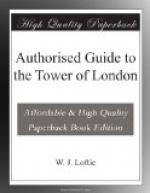Its lower storey is the oldest building next to the Keep; it was, with the Lanthorn (rebuilt on the old foundation in 1884-5) and Cold Harbour Towers, part of the original Norman plan. The upper storey was rebuilt by Henry III, who made it the entrance to his palace on the east. The Great Hall, memorable as the scene of Anne Boleyn’s trial, adjoined it, but was pulled down during the Commonwealth. In 1360 the records of the kingdom, which had previously been kept in the White Tower, were removed here, and this is called in ancient surveys sometimes the Record, and sometimes the Hall Tower. The present name is said to be derived from the imprisonment of Yorkists after the Lancastrian victory at Wakefield in 1460. It is used now for the safe keeping and exhibition of
The Crown Jewels.
The visitor who has obtained a ticket passes up a short stair and finds himself in a well-lighted circular apartment in the Wakefield Tower. The deep window recess opposite the door was fitted up as a small chapel, with Aumbry, Piscina, and Sedilia. Tradition says that Henry VI used it for his devotions when a prisoner in the Tower, and was here murdered. In the centre, in a large double case, are arranged the splendid objects which form the English Regalia. The following are the most remarkable:—
The King’s Crown. It occupies the highest place in the case. It was constructed in 1838 for her late Majesty’s coronation, the principal jewels being taken from older crowns and the royal collection. Among them, observe the large ruby given to the Black Prince in Spain in 1367. Henry V wore it in his helmet at Agincourt. With seventy-five large brilliants it forms a Maltese cross on the front of the diadem. Immediately below it is a splendid sapphire, purchased by George IV. Seven other sapphires and eight emeralds, all of large size, with many hundred diamonds, decorate the band and arches, and the cross on the summit is formed of a rose cut sapphire and four very fine brilliants. The whole contains 2818 diamonds, 297 pearls, and many other jewels, and weighs thirty-nine ounces and five pennyweights. The Crown was enlarged for His Majesty Edward VII.
The Crown made for the coronation of Mary of Modena, the second wife of James II. This is probably one of the oldest of the crowns, and contains some fine jewels.
The Crown made for Queen Mary II, for her coronation with William III.
St. Edward’s Crown, which appears to be the model by which all the later crowns have been fashioned. It was made for the coronation of Charles II.
The Prince of Wales’s coronet, with a single arch.
The Orb, of gold, with a cross and bands of jewels.
St. Edward’s Staff, a sceptre of gold, 4 feet 7 inches in length, surmounted by an orb which is supposed to contain a fragment of the true cross.
The Royal Sceptre.
The Sceptre of Equity, surmounted by a dove.




